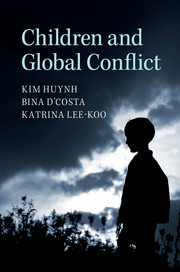Book contents
- Frontmatter
- Dedication
- Contents
- List of abbreviations
- Introduction: why children matter to global conflict
- 1 Children and armed conflict: mapping the terrain
- 2 Children and agency: caretakers, free-rangers and everyday life
- 3 Children and IR: creating spaces for children
- 4 The rights of the child: political history, practices and protection
- 5 Child soldiers: causes, solutions and cultures
- 6 Child forced migrants: bio-politics, autonomy and ambivalence
- 7 Children and peace building: propagating peace
- 8 Children and justice: past crimes, healing and the future
- 9 Who speaks for children? Advocacy, activism and resistance
- Conclusion
- Appendix
- Bibliography
- Index
1 - Children and armed conflict: mapping the terrain
Published online by Cambridge University Press: 05 May 2015
- Frontmatter
- Dedication
- Contents
- List of abbreviations
- Introduction: why children matter to global conflict
- 1 Children and armed conflict: mapping the terrain
- 2 Children and agency: caretakers, free-rangers and everyday life
- 3 Children and IR: creating spaces for children
- 4 The rights of the child: political history, practices and protection
- 5 Child soldiers: causes, solutions and cultures
- 6 Child forced migrants: bio-politics, autonomy and ambivalence
- 7 Children and peace building: propagating peace
- 8 Children and justice: past crimes, healing and the future
- 9 Who speaks for children? Advocacy, activism and resistance
- Conclusion
- Appendix
- Bibliography
- Index
Summary
Introduction
Children live in the world's most violent places. Children do not start wars, yet armed conflict affects and devastates their lives in many ways. Armed conflict can lead to disruption of their schooling and everyday practices; the loss of family members; forced displacement; poverty and health concerns; and brings physical, structural and psychological violence into their lives. There is no doubt that conflict victimises children and hinders their futures. Yet children have demonstrated the capacity not only to be shaped by conflict, but also to shape conflict in ways that are both predictable and surprising. In short, children have complex and distinctive relationships with conflict. These relationships are produced by the nature of the conflict around them, the investment that stakeholders in conflict make to their protection, and the capacities and decisions of children themselves.
This opening chapter examines the relationship between children and armed conflict by focusing upon the three core concerns of this book: children, armed conflict and the responses of international actors. It begins by mapping the conceptual terrain of these three concerns, highlighting the debates that arise in response to key questions regarding what it means to be a child, how armed conflict shapes children's experiences, and what responsibilities the international community has to child protection. Based upon recent research by the global child advocacy network, the chapter then turns to an empirically based overview of some of the impacts of conflict on children. It does so via ‘the six grave violations against children during armed conflict’ that are the focus of the UN Security Council. It then critically engages these six grave violations in order to reflect upon how they construct and reinforce conceptualisations of children, conflict and the international community's responses towards them. Furthermore, in demonstrating the complex relationship that exists between these three themes, this chapter highlights the role that children themselves play in shaping conflict and their own experiences of it.
- Type
- Chapter
- Information
- Children and Global Conflict , pp. 9 - 34Publisher: Cambridge University PressPrint publication year: 2015
- 1
- Cited by



